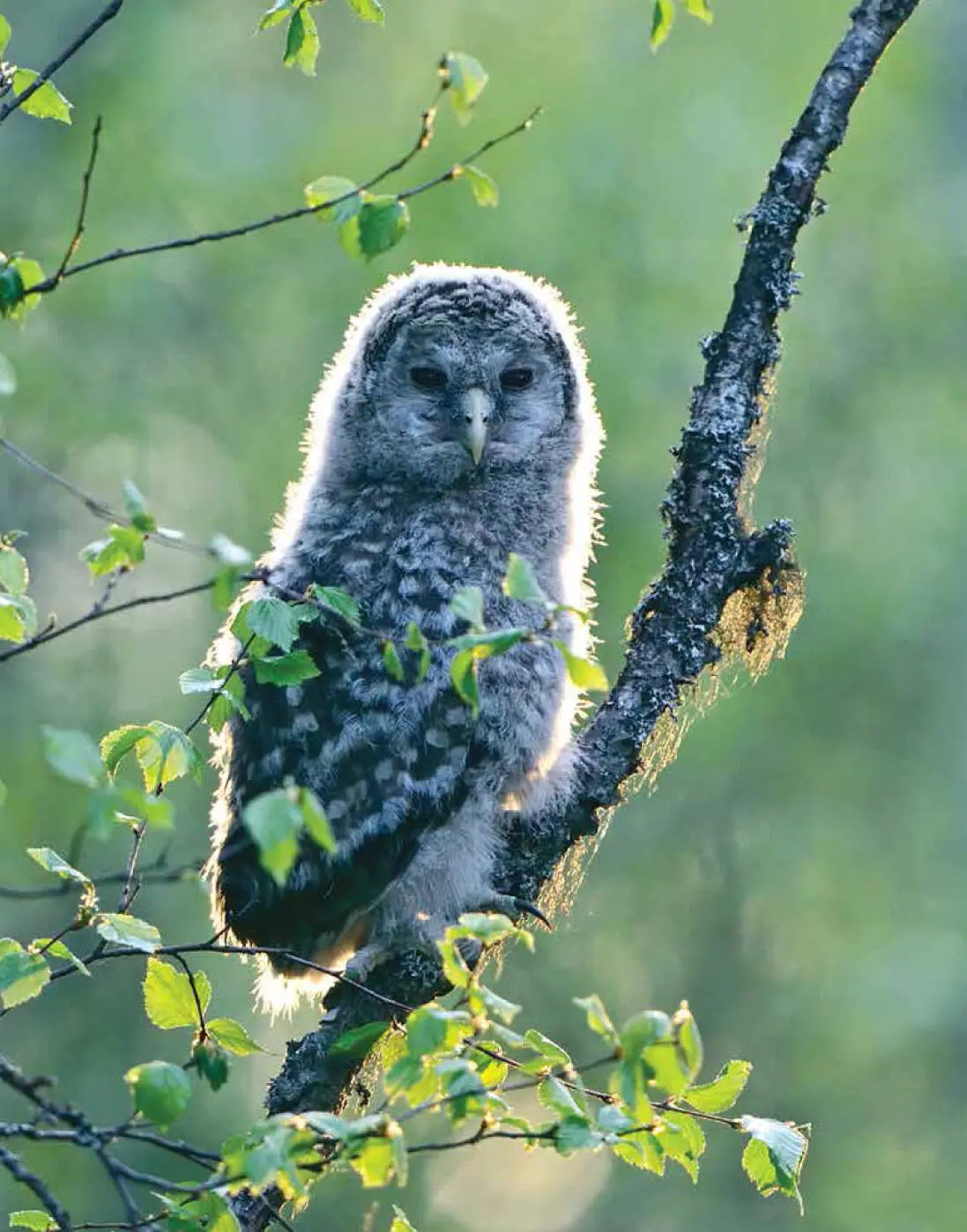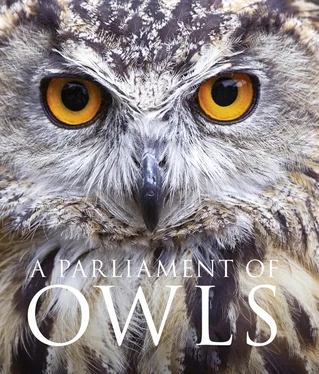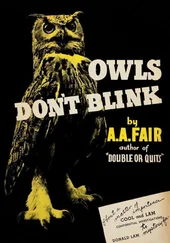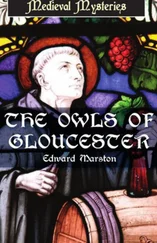The variety of prey taken across the owl group is extraordinary, ranging from flying ants to mammals as big as foxes and birds as large as eagles. Many species take prey larger than themselves, with the smallest owls punching well above their weight when targeting birds such as doves. The availability or otherwise of certain prey species can be critical to owls’ fortunes, none more so than voles, which in northern regions provide the staple diet for species such as the Short-eared Owl. In vole “boom” years, owl populations may soar; conversely, in “bust” years, they may crash, with the owls failing to breed or moving away en masse in search of food.

A fledgling Ural Owl still in its downy juvenile plumage.
Among the more surprising items on the owl menu are other owls, with species such as the Tawny Owl and Eurasian Eagle Owl frequently preying upon smaller relatives, such as the Long-eared Owl. The practice of one predatory bird feeding upon its cousins is known as intraguild predation, and certain owls—notably the Eurasian Eagle Owl, again—are notorious in this respect, often taking hawks, buzzards, and other diurnal raptors from their nighttime roosts. Owls tend to swallow smaller prey in a single gulp, while larger prey is dismembered using the bill and talons. Either way, they cough up the indigestible parts—bones, fur, feathers, insect heads and wing cases—in a sausage-shape pellet, which takes about six hours to form. Regular owl roosts and nest sites are often betrayed by the piles of pellets that accumulate beneath. They can prove very useful to scientists, both identifying the species and shedding light on its prey and feeding habits.
Being nocturnal, many owls are more often heard than seen. The best-known calls are the hoots of the eagle owl (Bubo) and wood owl (Strix) genera, notably the Tawny Owl, whose fabled “too-whit to-whoo” has become the universal voice of spooky graveyard thrillers. However, many owls do not hoot at all. Other sounds vary from the hissing screams of barn owls to the insect-like chirruping of scops owls, the metronomic whistles of pygmy owls and the dog-like yapping of the aptly named Barking Owl
. Calls are unique to each species and, for the scientist and birdwatcher, they provide diagnostic clues to an owl’s identity.
Owls are unusual among birds in that most do not visibly open their bills when calling but rather inflate their throats, like a frog. They are most vocal at the start of the breeding season, as males reclaim their territories and attract females. Most species are monogamous, and many form lifelong pairs, retaining the same territory and nest sites for numerous years. In addition to calls, pairs consolidate their bonds with mutual preening, gifts of food from male to female, and choreographed courtship rituals, including wing-clapping display flights.
Males show their mates around potential nest sites, but females generally make the choice. Most nest in tree holes, especially those excavated by woodpeckers, but some use crevices among rocks and tree roots. Many will also reappropriate the old stick nest of another bird, such as a crow or raptor, and a few even nest in a crude hollow on the ground, trampled into the long grass. None constructs a nest, and few provide any kind of lining. Owls’ eggs are generally white and quite spherical in shape, with the clutch size ranging from one or two in many species to an amazing dozen or more, during peak years, for those whose breeding is tied to the abundance of prey such as voles. The female generally incubates the clutch, while the male hunts to provide for her. Once the hatchlings have grown strong enough, both parents hunt together in order to provision their voracious brood. Although owls may be poor nest builders, they are excellent nest defenders, and species such as the Tawny Owl and Ural Owl
are notorious for the attacks they launch on intruders. Other tactics are deployed, including puffing up the feathers to exaggerate their size, and feigning injury to distract an approaching predator away from the vulnerable chicks.
The youngsters grow quickly and generally leave the nest before they are fully fledged, hanging around for a while in a downy mesoptile stage before they perfect their flying and start to hunt for themselves. The young of some larger owls may remain with their parents for several months, sometimes long enough to prevent the parents from breeding the following year. In many species, especially those found in colder northern regions, breeding success is dictated by weather and food supply, and in poor years they may not attempt to breed. Once an owl gets through its tricky early years, many species go on to live long lives. Longevity records among captive owls have topped fifty years for both the Eurasian Eagle Owl and the Great Horned Owl.
Owls and people
Owls have played a significant part in human culture since before recorded history, their all-seeing eyes inspiring both fear and reverence, and prompting their symbolic depiction as, variously, harbingers of doom and emblems of wisdom and prosperity. They appear in French cave paintings dating back 15,000 to 20,000 years and in the hieroglyphics of the ancient Egyptians. In the United Kingdom, the spectral appearance and eerie call of the Barn Owl has led to numerous ghost stories, while in Jamaica the presence of a Jamaican Owl
outside a house has occupants reciting an incantation to avert disaster. In Japan, conversely, Blakiston’s Fish Owl
is revered by the Ainu people as “The God that Protects the Village.”
Whatever we think of owls, humans have given them plenty to contend with. In some parts of the world, owls have suffered direct persecution, either killed to ward off evil spirits or hunted for the pot. More serious, however, is the damage done to their environments. Deforestation, commercial agriculture, and river pollution have robbed owls of the habitats they need for breeding and hunting, while the use of rodenticides and other toxins have not only depleted the owls’ prey but often caused secondary poisoning to the birds themselves. Modern hazards also include man-made obstacles such as power lines and road traffic. Today, the International Union for the Conservation of Nature lists six owl species as Critically Endangered, twenty-six as Endangered, and another forty-three as Vulnerable or Near Threatened. As indicator species of a healthy environment, it is therefore the disappearance of owls, rather than their presence, that we should fear as a harbinger of doom.
Conservationists are doing their bit. BirdLife International and its partners are working hard to protect owls, whether through increased protection for their habitats or lobbying and education to prevent their persecution. More enlightened landowners, realizing that owls themselves are the farmer’s best natural rodenticide, are managing land for owls, setting aside rough pasture and other key habitat features they require, and providing nest boxes. Meanwhile, owls continue to bring great pleasure to numerous people, from fanatical “owlaholics” who devote their lives to collecting anything that depicts the birds, to hardened “world listers,” who race around the globe trying to tick off as many of its owl species as they can manage. Furthermore, there are those of us who simply love the wild, for whom that haunting voice in the darkness or unexpected flare of silent wings over a moonlit hedgerow represents all that is magical about these most enigmatic of birds.
BIOGEOGRAPHIC REGIONS (ECOZONES)
This map shows the world’s principal biogeographic regions as reflected in chapters one to five of this book. Chapter Six (Oceanic Islands) comprises parts of several other regions.
Читать дальше













